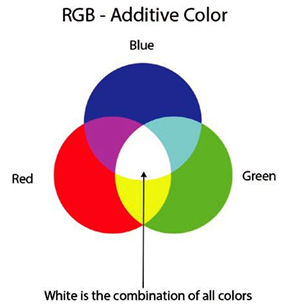The Science of Color – Preparation for Creating a Logo and Infographics-1
Color Theory and Harmony Rules with Adobe Color Online
Using colors in your logo or infographic project can be a bit intimidating if you don’t know what colors look best or coordinate well together. To understand colors, we need a brief overview of some of the science behind color.
The Science of Color
In our visually saturated world of images and graphics, for most sighted people, it’s hard to imagine a world without color. Color plays such an important role in choices such as what to eat, wear, purchase, branding, and mood. Everywhere that we go, there is color. But what is color? When we turn off the lights, we can’t see it. So, is color light? Yes, this is part of the story, but not all of it. To see colors, you do need light. Light is made up
of electromagnetic radiation. The main light source is the sun, but a light source could also be a candle or even a light bulb. The wavelengths or frequency that it emits and its intensity give us light. However, the human eye is only able to see certain wavelengths. This is known as the visible “spectrum” or visible light. Refer to Figure 2-2.

Figure 2-2. The sun shines through a prism, and a person sees a blue circle on a paper
Pure “white” light, for example, from a light source, is then broken down into the various rainbow colors within the spectrum (red, orange, yellow, green, blue, indigo, and violet) when it goes through a prism or lands on a substrate like paper or an object. In most cases, an object contains a pigment.
A pigment is a material that changes the color of reflected or transmitted light as a result of wavelength-selective absorption. For example, a blue object will absorb all other light in the white spectrum. But it will reflect back the blue of the object. So, as you can see, just having light is not enough to see color, we also need a pigment and a surface to separate the colors of light; otherwise, everything would be white.
Once the pigment is reflecting a color, we see the color; the information goes into the eye, and the receptor in our eye and our brain processes what color of “blue” based on the visible spectrum.
This is how it should be for all normal-sighted people “in theory,” but as we’ll see later, there are a few other factors going on, so we don’t all come to the same conclusion. What we need to know at this moment is that to see color, we need light, a surface with pigment, and a person to view the effect that is produced.
Now let’s look at how color is classified.
Light or objects that emit light, like our computer screen, use what is known as additive color. Refer to Figure 2-3.

Figure 2-3. RGB additive color diagram, white is a combination of all colors
